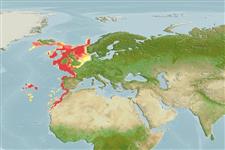Common names from other countries
Environment: milieu / climate zone / depth range / distribution range
Sinh thái học
; Mức độ sâu 37 - 750 m (Ref. 356). Temperate; 71°N - 22°N, 34°W - 7°E
Eastern Atlantic: from Morocco to Atlantic coast of Europe and southern coast of Iceland.
Length at first maturity / Bộ gần gũi / Khối lượng (Trọng lượng) / Age
Maturity: Lm 10.5, range 13 - ? cm Max length : 22.1 cm CW con đực/không giới tính; (Ref. 2761); Khối lượng cực đại được công bố: 1.9 kg (Ref. 2761)
Maximum carapace width: 20.0 cm (Ref. 435). Higher rate of female individuals in shallower strata, 200 to 400 m, and male individuals has a higher rate in deeper strata, 400 to 600 m. Landings of 10,000 per year (Ref. 2753). Unimodal size frequency distribution for both sexes (Ref. 2753, 2761). Occurs at depths from 37 to 700 m (Ref. 2761; 150 to 750 m in Ref. 356; 37 to 620 m in Ref. 435; and sublittoral to 700 m in Ref. 2753). Found on varied substrata (Ref. 2761). In general, species under the family Cancridae are omnivores, predators, or scavengers (Ref. 3477)
Exhibits spawning migration that results in ovigerous females occupying different territory from the rest of the population (Ref. 2753).
Fischer, W., G. Bianchi and W.B. Scott (eds.). 1981. (Ref. 435)
IUCN Red List Status (Ref. 130435)
CITES status (Ref. 108899)
Not Evaluated
Not Evaluated
Human uses
Các nghề cá: Tính thương mại
| FishSource | Biển chung quanh ta
Các công cụ
Các nguồn internet
Estimates based on models
Preferred temperature
(Ref.
115969): 6.8 - 14.1, mean 9.6 (based on 211 cells).
Thích nghi nhanh
Chiêù cao, thời gian nhân đôi của chủng quần tối thiểu là dưới 15 tháng (Fec=484,800).
Vulnerability
Low vulnerability (10 of 100).
Price category
Unknown.
